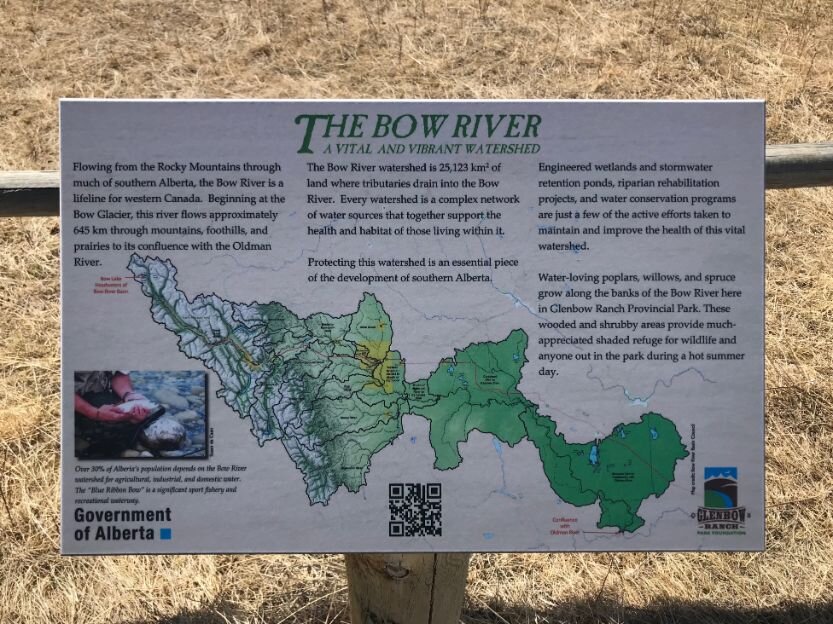Glenbow Ranch: A Park With An Amazing View / History
I have been meaning to explore the Glenbow Ranch Park for a few years now, but it never seemed to get to top of my list of “places to explore.” So when friends invited us out for an afternoon walk and suggested Glenbow Ranch, I jumped at the idea.
We picked a perfect early spring day with the temperature in the high teens and little wind. Upon arriving at the park, you are immediately awed by the combination of the iconic Alberta big blue sky, the snow-capped, rugged Rocky Mountains and the rolling foothill grasslands. You can see for miles and miles and miles - just like The Who’s 1968 hit song.
The parking lot was almost full, but no worries. The park is huge (3,200 acres) so people quickly spread out on the many trails, some paved and some dirt. It is very family-friendly. I was surprised by the number of very young children. It is also dog-friendly, but they must be leashed.
The trails loop around so you can easily choose how long you want to walk. For example, the Outer Loop is 9.3 km in total but you can easily cut that in half or a third. And there are flat sections for those looking for an easy walk and hikes up the hills if you want something more vigorous. Warning: there a pretty steep hill to go down at the beginning and up at the end – funny how that works!
History
I was surprised by the number of storyboards, sharing the history of the ranch. I have included all of the ones we encountered on our 2.5 hour walk.
The lands of the Glenbow Ranch have a history spanning thousands of years:
Native people corralled bison in the coulees and established tipi camps on the uplands and lowlands
The park used to be part of historic Cochrane Ranche
In 1891, Glenbow was identified as a water stop on the Canadian Pacific Railway mainline
By 1903, the Canadian Pacific Railway had established a station at Glenbow
Between 1907 and 1912, a Porcupine Hills sandstone quarry operated here; its blocks and finished decorative pieces were used in construction of Alberta's Legislature Building
When the quarry closed, a brick plant in the valley was opened; many workers stayed in the valley to continue working, while others moved away to cities or to work on nearby ranches
With the start of World War I, the brickyards also shut down
The population of Glenbow slowly declined until the last residents moved away in 1927
Chester Rhodes de la Vergne sold Glenbow Sheep and Horse Ranch to Eric L. Harvie in 1934
it remained a private ranch until 2006, when the Harvie family and the Government of Alberta created what would officially become "Glenbow Ranch Provincial Park" in 2008.
(Source: Glenbow Ranch Foundation website)
FYI: The Harvie Family are the decedents of late Eric Harvie, the Calgary lawyer, oilman and philanthropist who established the Calgary’s Glenbow Museum, Heritage Park, Devonian Gardens and donated the land for River Park in Calgary.
What You Need To Know
Location: 10 km west of Calgary on Highway 1A
Parking is free
Bikes of all types welcomed
Bring water, sunscreen and snacks
Washrooms available
Day Use Park only (no camping)
25-km of pathways, well-marked
Visitor Center has maps
Limited picnic areas
Bring a camera or sketchbook
Last Word
It would be interesting to visit the park at different times of the year to experience how it looks during the different seasons. I was amazed at the size of the ice chunks on the Bow River and that the ice along the river’s south bank was at least 10 feet thick. In a few weeks, I expect it will become a lush green as the grasslands and trees get their spring colour. Then late summer and early fall, everything will turn golden. Make sure you go on a day when you can experience Alberta’s crystal clear, deep blue skies.
Funny thing? As much I enjoyed the walk in nature, I still think I prefer to walk in urban neighbourhoods. But that’s just me!





























